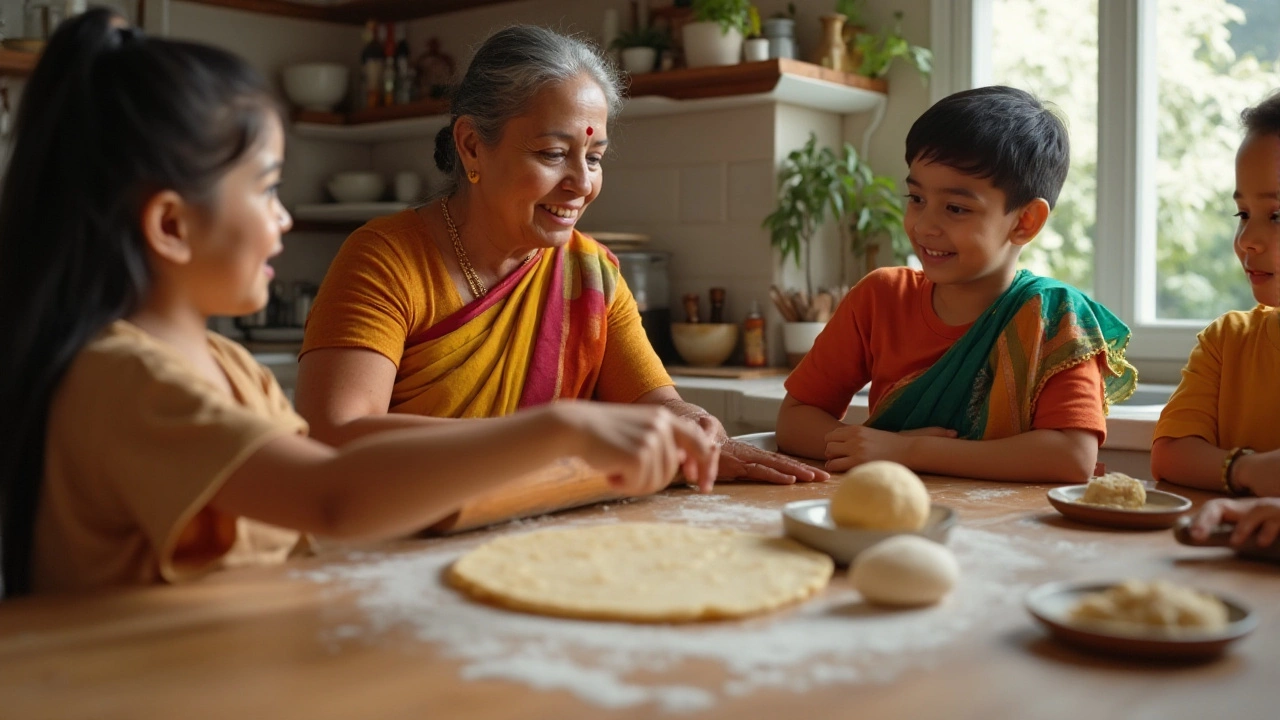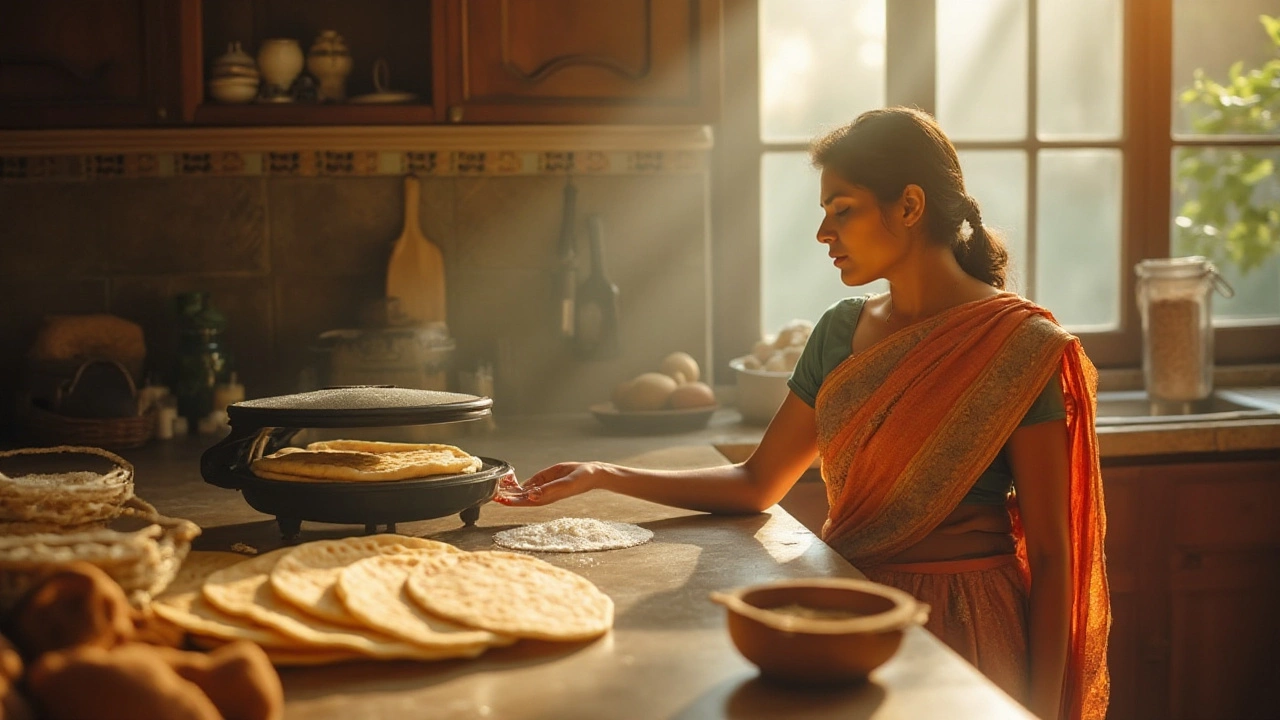19 Jan 2025
- 0 Comments
Roti, a beloved flatbread, is a staple in many households across the globe. But for those using a roti maker, maintaining its softness can sometimes be a challenge. If you’ve ever wondered why your rotis come out harder than expected, you're not alone. Let's delve into some key reasons and handy tips for achieving perfectly soft rotis every time.
Creating the perfect roti in a roti maker requires more than just a push of a button. It involves understanding the science behind dough preparation, the role of resting, and the nuances of temperature and timing. By paying attention to these elements and understanding where things might be going awry, you can make soft and delightful rotis that will impress and satisfy.
- Understanding Dough Consistency
- The Importance of Resting the Dough
- Proper Heat Settings
- Timing Is Everything
- Using the Right Flour
- Testing Adjustments and Practice
Understanding Dough Consistency
Creating the right dough consistency is perhaps the most vital step when making roti in a roti maker. The dough is the foundation of your roti, and its quality directly influences the texture and softness of the end product. A dough that's perfectly soft and pliable will lead to rotis that are not only delicious but also fluffy and tender. So, it's essential to get the balance just right.
When making dough for roti, one of the most common mistakes is adding too much water or too little. The rule of thumb here is that the dough should be softer than what you'd prepare for roti made on the stove. A good way to test if you've achieved the correct consistency is to press the dough with your thumb; it should spring back lightly without sticking to your finger. If your dough is too firm, it will yield dry and hard rotis, while too soft, sticky dough can make them difficult to roll out.
Another important factor is the kneading process. Kneading the dough properly ensures that gluten in the flour develops correctly. Gluten gives structure and elasticity to the roti, making them puff up while cooking. Experts often recommend kneading the dough for at least 10 minutes. Dough that is not kneaded long enough may not achieve the right elasticity, and your rotis might turn out hard or crumbly. An essential tip from seasoned roti makers involves resting the dough.
An ancient proverb says – ‘A dough well-rested is a roti well-cooked.’ The resting period allows moisture to distribute evenly, making it easier to roll out and cook.This resting time, preferably around 20 to 30 minutes, helps the gluten relax and the dough to settle into the perfect consistency for rolling. This simple step can sometimes be the difference between success and failure in roti making.
The type of flour used also plays a significant role. Whole wheat is the traditional choice, allowing for a stronger gluten network, which keeps rotis supple. Using the right flour ensures you get a maximum yield from your dough and enriches the flavor of the final product. Some people mix in a bit of all-purpose flour to add softness, but too much can affect the authenticity. Consider experimenting with different brands as each can have a slightly different composition and moisture content.
The Importance of Resting the Dough
Resting the dough is an often overlooked step in the roti making process, but it is paramount for achieving the desired softness and pliability. When you allow the dough to rest, the gluten in the flour has time to relax. This might sound technical, but it's a simple yet crucial aspect that can make a world of difference. Gluten development gives the dough its stretchy, elastic characteristic, essential for the dough to roll out smoothly and to puff up nicely during cooking. By not allowing the dough enough time to rest, you risk ending up with a tight and hard dough, leading to tough, unyielding rotis.
Think of gluten as the webbing inside the dough that captures air, which helps create those delightful air bubbles when the roti cooks. Gluten strands form when water meets flour, but they are initially tight and resistant. Resting allows these strands to mellow and spread out uniformly. This results in a smoother, softer dough that’s easier to work with and yields delicately puffed rotis. The typical rest period is around 20 to 30 minutes, but this can vary depending on factors like room temperature and the type of flour used.
According to food writer Harold McGee, "Gluten unfolds and reconnects in new patterns as it relaxes over time. With a short rest, the dough cooperates better under your rolling pin."
This enlightening quote from "On Food and Cooking" provides a deeper understanding of why resting isn't just a step but a transformation process.While commercial roti makers may speed up production, incorporating this traditional resting period into your routine could redefine the texture of your rotis dramatically.
Besides gluten, resting also allows for other processes like flour hydration and fermentation to occur. Hydration ensures that every bit of flour absorbs water fully, which contributes to dough elasticity and smoothness. Slight fermentation from wholemeal flours can add a depth of flavor and an aromatic softness to the end product. Modern bread recipes even capitalize on this by using longer fermentation times for more flavor complexity. Although roti is different from bread, the underlying principles of dough preparation share remarkable similarities.
If you aim for roti that not only looks good but also melts in the mouth when warm, implementing this simple resting trick can work wonders. This habit doesn't just make for better rotis — it turns a routine cooking task into a somewhat meditative process, allowing you to slow down, appreciate the ingredients, and ultimately create something delicious from scratch. So the next time you knead your dough, remember the impact of those precious minutes spent resting and how this small but significant pause can lead to softer, chewier, and more enjoyable roti making.

Proper Heat Settings
One of the pivotal factors in ensuring your roti emerges soft rather than rock-hard lies in getting the heat settings just right on your roti maker. The heat setting impacts how your dough cooks and, ultimately, the texture it takes on. Many new users of roti makers assume that cranking the heat up will speed up the process. Unfortunately, too much heat can cause the roti to become crispy and lose its soft quality, almost akin to a cracker.
The secret is to start with a moderate heat setting. Begin the cooking process on medium heat to allow the dough to gently expand and cook through. If your roti maker provides temperature readings, aim for a steady 160 to 180 degrees Celsius initially. A lower heat setting lets the moisture distribute evenly across the dough, which is crucial in keeping the roti soft. This step ensures that the dough isn’t aggressively drying out before it’s properly cooked.
It is essential to note that achieving perfect rotis also hinges on the dough's moisture content in sync with the heat applied. The balance between these two will determine the result. To illustrate the significance of this balance in roti making, one home cook, Maya Khanna, notes:
"Patience and the right amount of heat go hand in hand. Perfectly soft rotis are a result of respecting both time and technique, not just the gadget."
Once you’re comfortable with the medium heat, gradually increase to high heat for the final moments of cooking the roti until it puffs up slightly. This process ensures the internal moisture is instantly steamed, further softening the texture. Keep an eye on the thermostat or setting indicator on your roti maker; this will act as your guide. Remember, every roti maker might slightly differ, so spending some time understanding your specific device's quirks is beneficial.
Understanding heat distribution on your roti maker surface is also key. Some devices heat unevenly, which might result in one side cooking faster. To combat this, regularly rotate the roti or try out different spots on the surface of the roti maker. This extra little effort can go a long way in ensuring even cooking, which is why users often trade tips about their experiences with different brands. Such insights can be invaluable in tailoring the heat settings to suit your specific needs.
Besides temperatures, be mindful of the duration your roti stays on the heated surface. If you let it cook for too long, even at lower temperatures, it could lose its moisture, resulting in hardness. A combination of the right heat level and an optimal cooking time is what ultimately transforms dough into deliciously soft rotis. Practice, patience, and a meticulous approach to heat settings can elevate your roti-making from headaches to highlights.
Timing Is Everything
When it comes to making the perfect roti in a roti maker, timing is as crucial as the ingredients you choose. Many people often rush the process, hoping for quick results, yet this can be a reason why roti turns out hard. The science behind roti making is delicate, where even a few seconds can make or break your bread. Understanding how long each step should take helps maintain the soft texture we love.
Once your dough is ready and rested, the time it spends on the roti maker is crucial. Timing determines how much moisture evaporates, directly impacting the roti's softness. If left on heat for too long, the roti can end up dry and stiff. Each roti maker is different, so it's essential to figure out the sweet spot for yours. Experimenting and timing the cooking process ensures that the heat penetrates evenly, resulting in a soft and perfectly cooked bread.
Moreover, the timing process starts even before the roti hits the heat. Allowing the dough to rest for the right amount of time before cooking ensures that the gluten develops properly. This rest period, often overlooked, facilitates even rolling and cooking, leading to a better texture. Dough that hasn’t rested long enough can lead to uneven cooking results, whether in texture or doneness.
Once on the pan, the key is to keep a close eye on it. Too little time on the initial side can result in a raw center, while too much can lead to a dry surface. A perfectly cooked roti puffs up due to the heat, allowing inner steam to cook it uniformly. This steam gathering relies heavily on timing – capturing that moment is vital for soft roti success.
"The art of making a perfect roti lies in recognizing the moment it starts to puff up, balancing the heat and timing to achieve even cooking," remarks renowned chef Anjum Anand.
Even after artistry of puffing and cooking, timing continues. The sequence of how quickly you wrap the cooked roti in cloth or foil helps retain moisture, keeping it soft until it’s ready to be served. Keeping these steps timed precisely requires patience, but mastering timing in your roti-making process will ultimately provide the soft and pleasing result that pairs beautifully with any curry.

Using the Right Flour
The type of flour you use plays a crucial role in determining the texture and softness of your roti. Choosing the right flour is akin to setting the foundation for your culinary creation. Traditionally, rotis are made with whole wheat flour known as 'atta'. This type of flour is specifically milled to have a fine and soft texture, and it is rich in gluten which helps the dough stay elastic and pliable. However, all whole wheat flours are not created equal. Variations in milling processes and grain types can result in subtle differences in the flour quality, which directly affects the outcome of your rotis.
When selecting your flour, checking the protein content can be beneficial. A higher protein content means more gluten formation, which can help in keeping the roti pliable. However, too much gluten might make the roti chewy rather than tender. Many cooks recommend experimenting with different brands of flour or even blending it with a little all-purpose flour to achieve the desired texture. This blend can introduce more gluten bonds, enhancing the elasticity of the dough without making it overly tough.
Storage of flour also influences its performance. Freshness matters, as older flour can lose its moisture content and lead to drier rotis. If your flour is stored in a humid climate, it might absorb moisture, altering the dough's consistency. Keep your flour in a cool, dry place, possibly in an airtight container to maintain its quality for longer.
"The key to a perfect roti lies significantly in the quality of the flour," states renowned chef and culinary expert Anjali Pathak. "Understanding your flour's properties can transform the way you tackle this simple yet complex flatbread."
Another critical factor to consider is the sifting process. Sifting the atta before mixing can help aerate it, leading to even softer rotis. While it might seem like an extra step, sifting can remove any lumps and ensure that the flour mixes uniformly with water. This technique is recommended by many experienced roti-makers for achieving consistent softness across batches.
If you're open to experimentation, there are newer alternatives like multigrain or millet flours, which can be used alongside the traditional wheat flour. Although they introduce different flavors and nutritional benefits, they can affect gluten content and, consequently, the roti’s texture. The best practice is to start with small amounts and adjust based on the desired taste and consistency.
Testing Adjustments and Practice
Achieving the perfect roti isn't just a fluke; it involves consistent testing and practice. Many home cooks face the reality that the first attempt might not yield the desired softness. But don't get discouraged. Understanding the need for adjustments and continuing to hone your technique is the key to success. Even experienced chefs will tell you that cooking is both an art and a science that requires a delicate balance of ingredients and techniques.
When you’re experimenting with your roti maker, start by slightly altering one factor at a time. It could be the dough consistency – maybe you need a tad more water, or perhaps slightly less flour. Are you resting the dough long enough? Try varying that time to see how it impacts the result. Note how longer resting times can sometimes help with elasticity, leading to a softer texture in the final product.
Consider keeping a journal with your adjustments. Jotting down the changes you make will help you pinpoint what works best for creating a soft roti. This can be especially helpful if you've introduced a new type of flour or altered your pressing technique. Don't forget to assess whether the thickness of the dough after pressing can make a difference in texture upon cooking. An overly thick roti may not cook evenly, leading to hard spots.
Experimenting with heat settings is another avenue worth exploring. Some roti makers come with adjustable temperature settings. Different flours and moisture levels in your dough may respond better to a slightly lower or higher temperature. Remember, even a small temperature tweak can measurably change texture and pliability. Allow your creative side to take charge as you mix and match these factors. There’s no one-size-fits-all solution, and variations provide valuable learning experiences.
As you grow more confident, practice frequently and develop an intuitive feel for your methods. A practical approach often yields a stronger understanding, and indeed, even appreciation for roti-making. Encourage yourself to celebrate small successes, as mastering this skill doesn't happen overnight. Embrace the journey, learn from each batch, and immerse yourself in both the trials and victories. You may not have instant perfection, but with perseverance, you'll consistently craft delectable, soft roti that truly impress.
"There’s magic in the mnemonic: try, test, tweak, taste. Becoming an expert in the kitchen requires patience and curiosity." - Estelle Thompson, Culinary Writer
